|
Estone Technology MJ-100
Experienced US-based OEM/ODM offers tough and rugged two-pound Android tablet for various markets
By Conrad H. Blickenstorfer; photography by Carol Cotton
Share on:



RuggedPCReview.com took a detailed look at Estone Technology's MJ-100 rugged Android tablet. The review is a little different because the MJ-100, and in fact all of Estone's computing products, are OEM designs and not branded products that will directly go to end user customers. In other words, in addition to making available products like the rugged MJ-100 Android tablet that's the subject of this review, Estone Technology can design and manufacture products per customer specifications. So let's give a brief introduction to Estone Technology first.
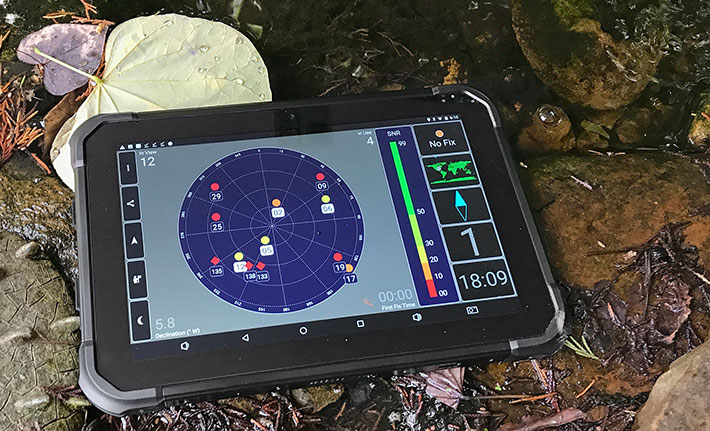
Longtime readers of RuggedPCReview.com may remember the Norco PPC-3308/Habey R8 we reviewed in 2012, one of the earliest rugged tablets available with Android. Well, Chinese Norco Intelligent Technology goes way back to 1991 as a designer and manufacturer of embedded and industrial boards and PCs. In 2008 they set up their Habey USA subsidiary, and eventually spun off Estone Technology in Toledo, Ohio, as a provider of OEM/ODM solutions focussing on tablet and Panel PC products. Today, Estone offers about a dozen different tablet platforms of various sizes, some targeted at medical markets, others as general purpose rugged tablets for various industrial and vertical markets.
While in this article we're covering the company's MJ-100 Android tablet specifically, much of the discussion centers not only on this particular tablet product, but on OEM market products in general.
The role of OEMs/ODMs
Back in the day, most products were made where a company was located. They might procure a few parts here and there, but for the most part, everthing was designed, manufactured and assembled in one place. A prime example of that approach was Henry Ford's giant Rouge factory in Detroit. Iron ore and other raw materials went into the complex on one side, cars came out on the other.
In today's far more complex world, making everything in one place is, with rare exceptions, no longer feasible. Parts are procured from all sorts of places and assembled in various locations, depending on cost and logistics. This development gave rise to OEMs — Original Equipment Manufacturers — and ODMs — Original Design Manufactures. OEMs make a product per the exact design and specifications of the company that ultimately sells the product with its name on it. ODMs design and manufacture a product entirely by themselves. and then sell the product to companies who put their name and brand on it.
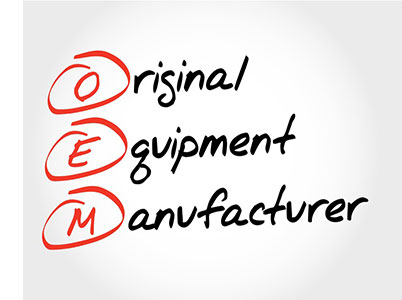 How important are OEMs and ODMs today? Very. Most consumer electronics products today are not actually made by the companies most people think make them. Few who are not industry insiders, for example, have heard of Hon Hai Precision Industry. Better known as Foxconn, Hoi Han had 2017 revenues of US$158 billion. That's more than General Motors, and much more than the annual revenues of IBM, Dell or Hewlett Packard. How important are OEMs and ODMs today? Very. Most consumer electronics products today are not actually made by the companies most people think make them. Few who are not industry insiders, for example, have heard of Hon Hai Precision Industry. Better known as Foxconn, Hoi Han had 2017 revenues of US$158 billion. That's more than General Motors, and much more than the annual revenues of IBM, Dell or Hewlett Packard.
Does all of this affect the rugged mobile computer market as well? It does. A large number of rugged handhelds, tablets, laptops and panels are made by OEMs and ODMs, and then sold under the names familiar in rugged computing markets. The relationships between OEMs/ODMs and the final sellers can assume many different forms. On the one side, an OEM may manufacture a product to very precise specifications for one customer only, and that customer has an absolute exclusive. On the other end of the spectrum, an ODM may sell the exact product to many customers who then may only put their brand label on it and nothing more. In between those two extremes are many shades of gray.
So what does all of that have to do with Estone Technology and the MJ-100 tablet? Well, Estone is both an ODM and an OEM, and one that specializes in making rugged computing products. Estone's current and prospective customers are companies that provide rugged technology to their own end user customers. The rugged computing market is much smaller than the consumer technology market, and Estone is much smaller than Foxconn. But it's essentially the same thing.
Who are Estone's customers? That's companies that have built their own businesses on catering to their own special markets. Estone's customers sell rugged computing equipment to their own customers together with expertise, software, turn-key solutions, service, and consulting arrangements. Estone's customers may be fairly large, well established names in the rugged computing market. Such customers may have precise customization requirements, their own color schemes, and their own brand names. But Estone's customers might also be resellers, large end users, system integrators, and more.
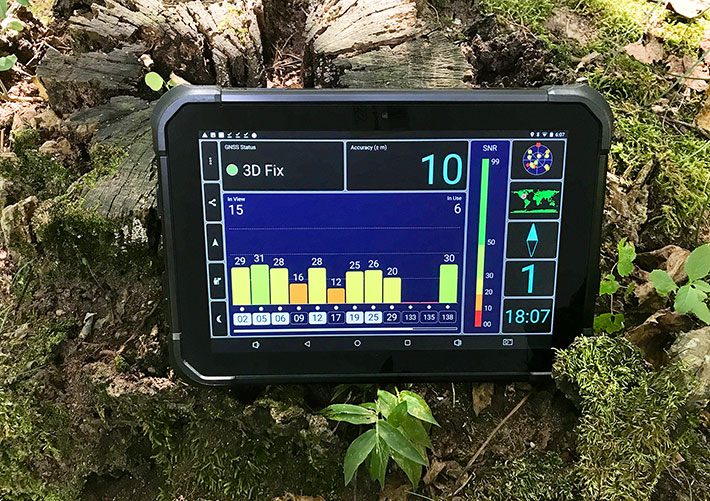
Why would they go to Estone instead of one of the rapidly growing number of Chinese or Korean rugged computing hardware OEMs and ODMs? Because Estone is right here in the US, in Toledo, Ohio, and in Walnut, California.
Estone's OEM implementation of the 10-inch rugged tablet platform
While many customers like doing business with one of the major rugged hardware and services brands, for others working with an OEM/ODM like Estone makes more sense. An OEM/ODM offers a cost advantage, OEM/ODM designs are more easily customizable to meet the needs of different customers, including "personalizing" a product with labels, colors, and materials. OEM/ODMs are also more likely to offer variable I/O and support different technologies, standards, and performance envelopes.
So let's look at the Estone MJ-100 Android tablet and see how the company went about creating what had to be a broadly appealing implementation of the generic 10-inch tablet form factor. Below you can see the MJ-100 from the front and from all four sides.
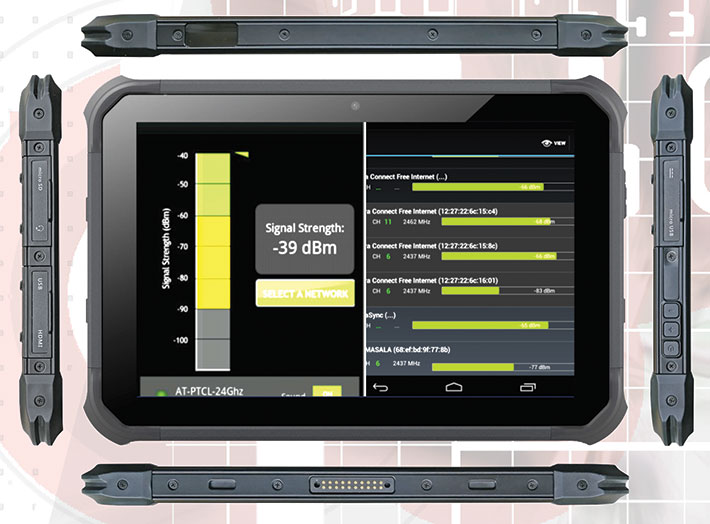
A challenge all tablet designers run into is how to make a tablet that doesn't look like every other tablet. Much to its credit, Estone came up with a clean design that takes the ubiquitous capacitive touch tablet form factor and subtly adds (easily replaceable and customizable) perimeter and corner protection as well as more wired connectivity and functionality than commonly available.
The 10.8 x 7.6 x 0.74 inch package makes the rugged MJ-100 barely larger, albeit a bit thicker, than your typical 10-inch consumer tablet. It looks elegant and professional and clearly like a tool for the job. Yet, despite its robust build and functionality, our review MJ-100 weighed just two pounds.
Below you can see the MJ-100's left (top) and right (bottom) side, with the hinged protective port covers removed for better viewing. On the left side you find a Type-D micro HDMI port, a standard USB 3.0 port, a standard 3.5mm audio jack, and a micro-SD Card slot.

On the right side are three physical buttons for power/sleep, and volume up and down. Next to the buttons is a slot, secured by a screw-on cover, for a SIM card. Next to that is a micro-USB port and the power jack.
Also of note is the scanner window built into the top of the tablet. Estone offers industrial-grade scanning without a "scanner bulge."
Optimized for performance AND low power
Being in the OEM market, Estone must carefully consider overall performance of their mobile computing product offerings. In addition to the usual size/weight/cost tradeoffs and balancing inherent in any mobile design, OEM customers may have widely differing priorities, ranging from lowest possible cost to highest possible performance. That's fairly common in Windows-based systems, but much less so in Android devices. As a result, processors must be chosen carefully both for performance and battery life.
 Keeping that in mind, processing power is supplied by a 64-bit 1.8GHz RK3399 from Rockchip Electronics, a Chinese semiconductor company that's been around since 2001. It is a System-on-Chip designed as a low power, high performance processor for computing, personal mobile internet devices and other smart device applications. Keeping that in mind, processing power is supplied by a 64-bit 1.8GHz RK3399 from Rockchip Electronics, a Chinese semiconductor company that's been around since 2001. It is a System-on-Chip designed as a low power, high performance processor for computing, personal mobile internet devices and other smart device applications.
Among others, the RK3399 has been used in various Asus and Samsung Chromebooks as well as numerous Linux applications.
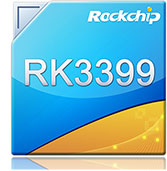 The RK3399 uses a dual-core ARM Cortex-A72 processor optimized for high performance, and a quad-core ARM Cortex-A53 processor optimized for low power, so aiming for the best of both worlds. A Mali-T864 GPU handles graphics. There's 2GB or 4GB of LPDDR3-1866 RAM and 32GB of eMMC 5.1 flash for mass storage. If more is needed, there's an externally accessible micro SD Card slot that appears to support the SDXC standard. The RK3399 uses a dual-core ARM Cortex-A72 processor optimized for high performance, and a quad-core ARM Cortex-A53 processor optimized for low power, so aiming for the best of both worlds. A Mali-T864 GPU handles graphics. There's 2GB or 4GB of LPDDR3-1866 RAM and 32GB of eMMC 5.1 flash for mass storage. If more is needed, there's an externally accessible micro SD Card slot that appears to support the SDXC standard.
It is not quite as easy to do reliable performance testing on Android devices as it is for Windows-based systems. That's in part because of large number of different chip designs and ancillary technologies used in Android devices, and in part because Android benchmarks apps are continuously updated, often rendering comparisons between different revs meaningless.
In our limited benchmark testing, the Estone MJ-100 meets or beats comparable products in the rugged handheld and tablet market. Benchmark testing included Vellamo Metal (1917), Vellano Multicore (2261), Vellamo Browser (4119), and PassMark Mobile (5665).
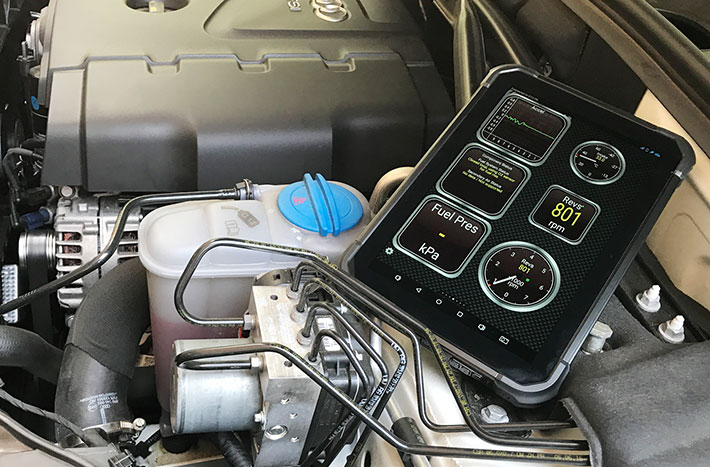
A look at Estone's tablet design and manufacturing
When it comes to rugged mobile computing gear, what's inside matters as much as, or more than, what's on the outside. That's because while exterior styling appeals to eyes (good looks) and hands (ergonomic design), what's inside determines how rugged, reliable, and durable a device really is. That is why dismantling and reassembling review units is part of the RuggedPCReview testing process. That way, we can see if a design makes sense, if ports will seal and protect as they should, whether there are connections that may come loose, how the battery is integrated into the unit, whether service and/or repair are possible, whether the device is upgradeable, and how clean and logical the design is.
All of this greatly matters in rugged devices, given the extra demands on durability and reliability. And what things look inside is even more important for OEM products because they go to customers who rebrand them for their particular target markets, resell them to their own particular customer in a particular field, or make them part of turn-key hardware/software solutions.
This means that OEM products must not only be designed from the ground up to be as flexible as possible, cover as many bases as possible, and allow as many configurations as possible. They must also be as easy and simple to maintain, upgrade or repair.
How does the Estone MJ-100 score in all those areas? Opening up the device is easy, and all that's needed is a small Phillips screwdriver. The protective corner bumpers come off first. Since they are not integrated into the housing they can be replaced separately, and Estone could probably make available customized ones. Then the four side covers come off. Here again, these pieces could easily come in different colors and textures, thus assisting in branding. The tablet's hinged protective I/O doors are screwed on and replaceable. Finally, undo 14 small screws that secure the backplate of the tablet to the front.
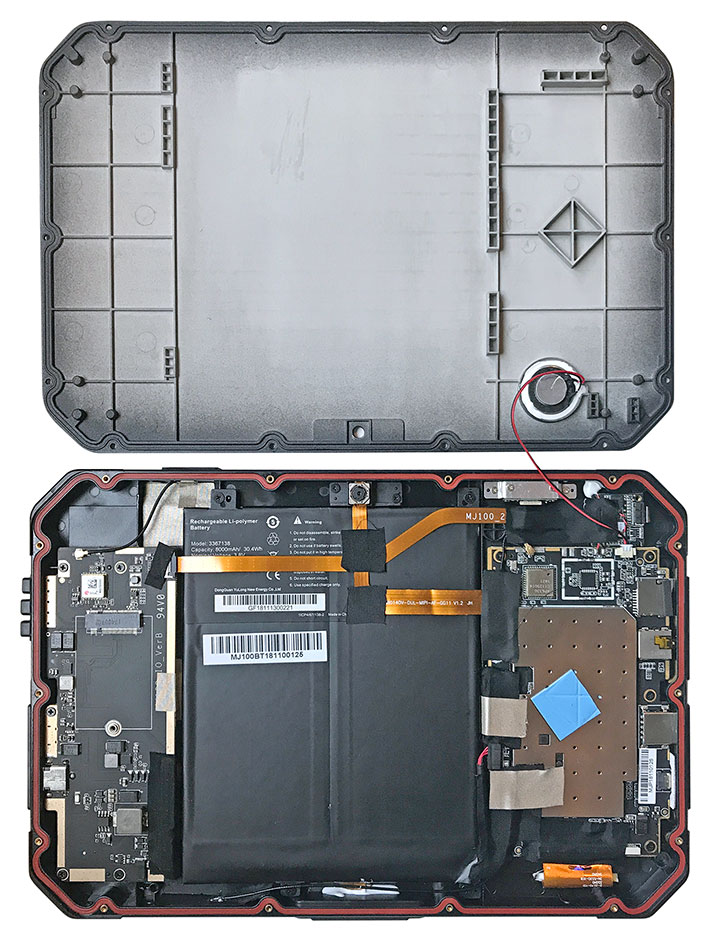
After that, separating the two halves of the tablet's housing is a piece of cake. The front consists of a shallow thermoplastic polyurethane box, the back of a magnesium plate. There's only one single wire between the two halves, the one for the speaker, and that disconnects easily. Sealing between the two halves is done with a single, long, replaceable square-profile rubber pressure O-ring type seal that sits in a simple groove. The red replaceable seal contrasts well with the black housing, making it easy to check fit and condition.
The overall construction of the MJ-100 is simple. Electronics are divided into two boards, one to the left and the other to the right of the large battery. Separating I/O this way makes it easier for a manufacturer to offer custom configurations for special needs and applications. All I/O is edge-mounted. Unlike high-performance Windows tablets with Intel Core processors, the RockChip RK3399 SoC-powered MJ-100 doesn't need a fan or extensive thermal management; a small metal cover over the processor and electronics conducts heat away to the magnesium backplate. The image below shows an infra-red look at the opened, operating MJ-100, taken with our FLIR ONE Pro thermal camera.
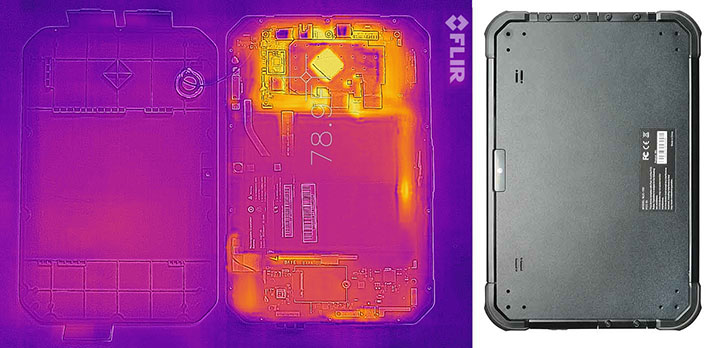
The MJ-100's battery is internal and not user-accessible. Our review unit had a 3.8V, 8,000mAH rechargeable Li-Polymer design providing 30.4 watt-hours, about 10 watt-hours less than that in the MJ-100's Windows-based MJC-100 sibling. Unlike some internal batteries that are next to impossible to replace, this one looks like it shouldn't be a problem.
Our unit came with an (optional) 1D/2D imager integrated into the top side of the tablet. The scanner module seems to be a Newland EM2096 640 x 480 pixel CMOS-based scanner/decoder board designed and manufactured by Dutch 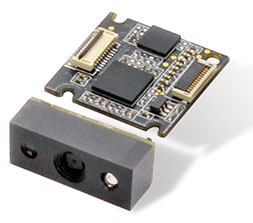 company Newland EMEA, a subsidiary of Fujian Newland Digital Technology Co., Ltd, to quickly decode even poor quality codes.
company Newland EMEA, a subsidiary of Fujian Newland Digital Technology Co., Ltd, to quickly decode even poor quality codes.
The scanner can read Code 128, UCC/EAN-128, AIM-128, EAN-8, EAN-13, ISBN/ISSN, UPC-E, UPC-A, Interleaved 2 of 5, ITF-6, ITF-4, Matrix 2 of 5, Industrial 25, Standard 25, Code 39, Codabar, Code 93, Code 11, Plessey, MSI-Plessey, GS1-DataBar, RSS-14, RSS-Limited, and RSS-Expand 1D barcodes, as well as PDF417, QR Code (QR1/2, Micro), Data Matrix (ECC200,ECC000, 050, 080, 100, 140), Chinese Sensible Code 2D codes. The module supports batch, trigger, sense, and continuous modes.
Overall, the interior of the Estone MJ-100 leaves a good impression. Quality components and engineering set the tablet apart from generic whitebox products, and the strong magnesium backplate adds both strength and thermal efficiency.
Contemporary display — 10.1-inch and procap multi-touch
Almost a decade after the iPad's introduction, the 10-inch screen of Apple's pioneering modern-era tablet remains the most popular size. Smaller means not much more space than today's big smartphones, larger means extra size and weight. 10 inches is also roughly the starting point for Windows 10. You can use Windows on smaller tablets, but we find it takes a 10-inch screen minimum to do real work with Windows.
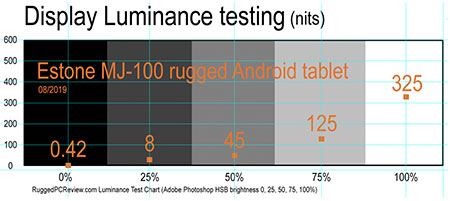 The Estone MJ-100 has a 10.1-inch capacitive multi-touch IPS display with 1920 x 1200 pixel resolution. That makes for 224 pixels per inch — plenty sharp enough for the intended applications. Since this is an IPS screen, there are perfect viewing angles and no color or contrast shifts when viewed from any angle. The display is listed in the spec sheet as having 220 nits luminance. The Estone MJ-100 has a 10.1-inch capacitive multi-touch IPS display with 1920 x 1200 pixel resolution. That makes for 224 pixels per inch — plenty sharp enough for the intended applications. Since this is an IPS screen, there are perfect viewing angles and no color or contrast shifts when viewed from any angle. The display is listed in the spec sheet as having 220 nits luminance.
"Nits" is the commonly used measure for display brightness. Nits is really candela per meter squared, or cd/m2, and that, per Google dictionary, is "the luminous intensity, in a given direction, of a source that emits monochromatic radiation of frequency 540 × 1012 Hz and has a radiant intensity in that direction of 1/683 watt per steradian."
Standard laptops generate about 200 nits. Consumer tablets and smartphones may go as high as 500 and 600 nits. And special purpose rugged laptops can generate as much as 1,500 nits. The MJ-100 display looked brighter to us than its listed 220 nits and, sure enough, we tested 325 nits, considerably more than most laptops. So Estone may have upped the luminance of the standard display, or our review unit may have had an optional brighter display.
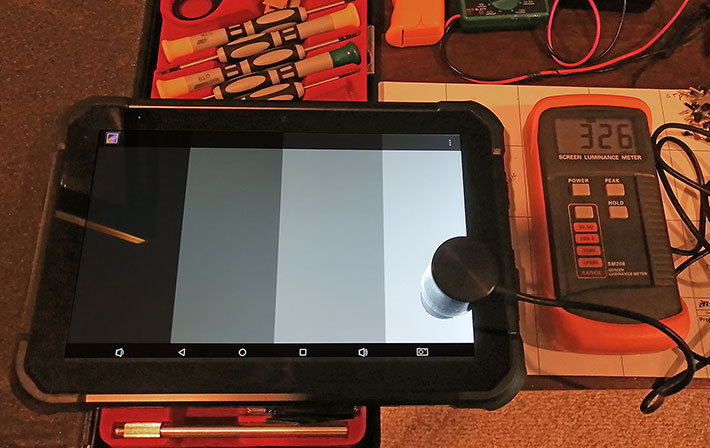
The images below provide an idea of what users can expect from the MJ-100 display outdoors. The picture below shows the MJ-100 side by side with an iPad Air 2. We measured the iPad at 415 nits, but visually the brightness difference to the 325 nits MJ-100 is almost unnoticeable.
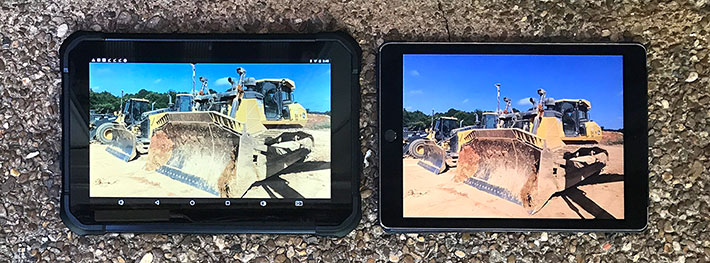
Like virtually all smartphone and tablet displays today, the MJ-100 has a "glossy" transmissive screen with optical treatments to offer as much outdoor viewability as possible. Glossy screens "pop" and make for vibrant displays, but outdoors it all depends on angle and reflections. The pictures below show the tablet outdoors on a bright late morning under various viewing conditions.
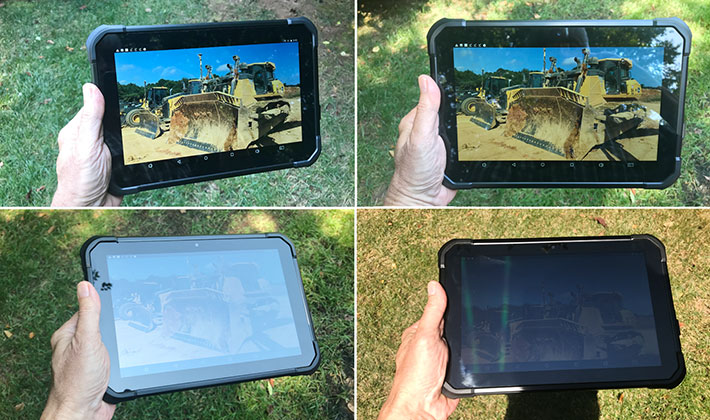
Overall, the MJ-100 display is impressive. It's bright and vibrant indoors, and bright enough for outdoor use under many circumstances. It offers near perfect viewing angles from all directions, without distracting changes in brightness, color, or contrast.
Android contemplations
Our review Estone MJ-100 tablet came with Android 7.1 "Nougat." One of the annoying things about Android is Google's rapid-fire release of new versions where every time everything is just different enough to baffle users. The quick release cycle also means that hardware often can't keep up with new software versions.
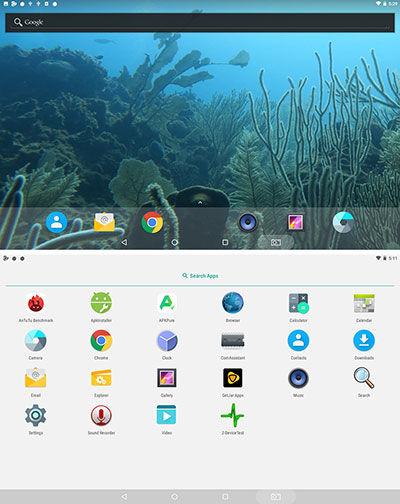 As of this writing (end of August 2019), Android 7.x is still recent enough to have a lot of life left. Another issue is the difference between Google GMS and Android AOSP. As of this writing (end of August 2019), Android 7.x is still recent enough to have a lot of life left. Another issue is the difference between Google GMS and Android AOSP.
GMS stands for Google Mobile Services and describes the Google authorized official version that has access to all of the popular Google apps and also the Google Play Store.
AOSP stands for Android Open Systems Project. It is standard Android and is led by Google itself, but the AOSP version does not come with social media-oriented Google apps such as Chrome, YouTube, GMail, Maps, Photos or the Play Store.
Our MJ-100 came with a lean and clean implementation of Android, with only about 20 apps. So we assume Estone used Android AOSP. Why?
If you've recently looked at almost any consumer Android device you already know why: those are jam-packed full of all sorts of apps and games and there's also the (awkwardly named) Google Play Store. Lots of clutter and temptation is definitely NOYT what employers want on devices deployed for work.
We're not going to go into great detail on all of that. There are various efforts to minimize the temptation to browse or play or download. Google itself launched "Android for Work" and also "Google Play for Work." Mayor vendors of Android devices often create their own enterprise-oriented utilities and tools. Third parties like 42Gears.com offer ways to to replace the standard Android desktop and control applications that are available to users.
The screen snaps above right show how we configured our review MJ-100. Without access to the Play Store we couldn't download some of our favorite benchmark apps and test utilities. So we went through some of the many third party app stores. Not a good idea. Many of those are, shall we say, less than safe, and we do not recommend going that way at all (if you absolutely need to, we'd use APKpure).
Cameras
Like virtually every tablet these days, the Estone MJ-100 has both a front and a rear camera. The front one is primarily for WiFi video calls and conferencing, and offers 2 megapixel resolution. The more powerful one in the rear is for documentation and general photography and comes standard with an 8 megapixel imager with auto-focus.
The onboard Android Camera app in our review unit could go as high as 8mp stills (3264 x 2448 pixels), using the 8mp imager to capacity, and 1920 x 1080 pixel FHD video. For video the camera tops out at 1080p/30fps. Android Camera apps usually have more settings and options that what is available in Microsoft Windows, but this one was quite sparse. The app offered time delay (off, 3 and 10 seconds), white balance (auto, sunshine, incandescent, fluorescent), 3DNR (on/off) and flash (on/off). Unlike the Windows version of the MJ100 that had panorama, video, photo, document, and whiteboard, the Android MJ-100 only offers Photo and Video modes.
The pictures below were shot with the MJ-100 rear camera in 3264 x 2448 mode. Click on the image to bring up a full-size version.
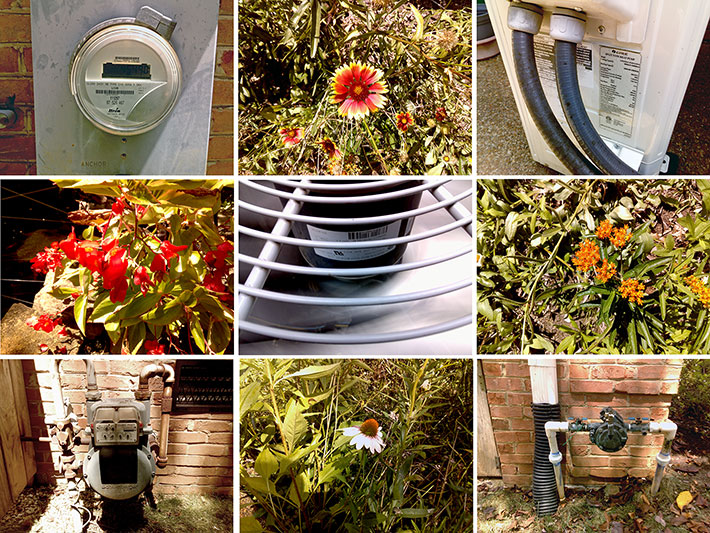
Given the incredible imaging quality of today's smartphones, users have come to expect a lot from their mobile device cameras, especially in Android devices. In that respect, the MJ-100 camera in our review unit didn't live up to expectations (or to what the cameras in the Windows-based MJC-100 sibling tablet offered). The cameras in the Windows version of this tablet did better, which is something we don't often see.
Tough and durable
Unlike premium smartphones and consumer tablets that are increasingly fashion statements and status symbols, OEM/ODM tablets like the Estone MJ-100 tablet are tools for the job. They are designed to get work done without needing a protective case, and without the need to be handled with the proverbial kid gloves. Any time you're more concerned with not scratching and not breaking a tool than actually using it the way it's supposed to be used, you have the wrong tool. The MJ-100 is not one of those fragile tools.
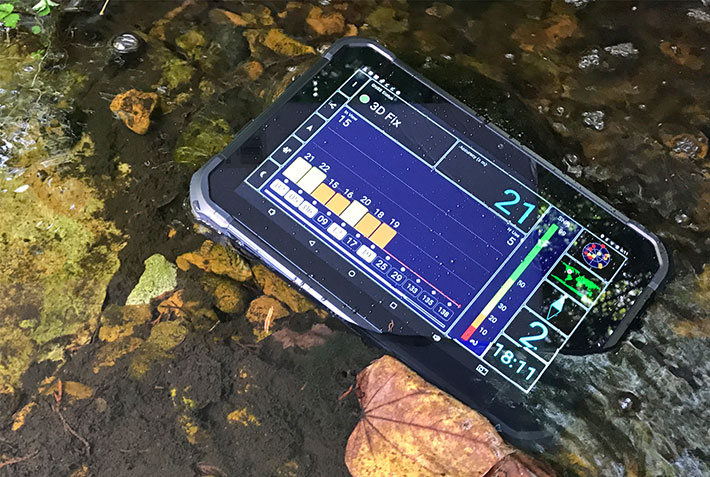
Instead, the MJ-100 makes it clear from the start that you can use it without worries. No screen protector needed, because the screen itself is of chemically hardened cover glass. There's no glossy metal that easily scratches, only that tough thermoplastic polyurethane, the rubber bumpers, and the magnesium back plate with a tough finish on it.
By established ruggedness testing standards, just how tough is this tablet? That's a bit more difficult to determine. The MJ-100 carries IP65 sealing where the "6" means it's completely dustproof, and the "5" that it is also protected from low-pressure water jets from all directions. So no worries about a spilling a soda on it or a bit of rain or more.
The device can also handle drops from four feet. That means it can easily survive falling off a desk or a cart. And four feet is also about the distance a tablet falls if it slips out of one's hands while using it in a standing position.
The stated operating temperature range of 32 to 113 degrees Fahrenheit (0 to 45 degrees Celsius) is narrow by SSD-equipped rugged tablet standards. It can easily get colder or hotter than that in many locations. And since many MJ-100 tablets will see lots of outdoor duty, the officially sanctioned operating temperature range should be wider.
Now do look at all the pictures below. That is some of the ruggedness and durability testing gear and instrumentation that Estone Technology uses to test the ruggedness of its mobile computing devices. One gets the impression that the MJ-100 rugged tablet may well be tougher than the few specs in the official brochure indicate.

And, in fact, the company's informational materials go into length about its considerable testing. Which includes aging, immunity to power line variation, liquids resistance, battery stress, thermal testing, temperature and humidity (both storage and operating), drop test, package drop, vibration, ESD, and moisture & salinity. List of testing performed on a particular device, of course, depends on the product and its intended purpose. We'd encourage Estone to make the results of all those tests available in its sales and promotional product literature.
Also note that the company provides product certification services both for governmental as well as for private technical commissions and software/standards licensing.
Summary: Estone Technology MJ-100
With the MJ-100, Toledo, Ohio based OEM/ODM Estone Technology makes available a budget-friendly 10-inch Android tablet solution suitable for a large variety of environments and applications. Estone offers the platform in different configurations and color schemes, suitable for all sorts of rebranding, reselling requirements, and well as for turn-key projects and solutions.

The MJ-100, which weighs just two pounds, features an elegant, polished look that emphasizes (but not flaunts) its inherent ruggedness. Its tough thermoplastic polyurethane and magnesium back design won't easily scratch or break, and its 10.1-inch capacitive multi-touch display with excellent viewing angles is crisp and sharp. The display on our review unit allowed easy viewing outdoors. The tablet's two cameras are remarkably good. The internal 30 watt-hour main battery easily lasts a full shift.
The performance provided by its hexa-core ARM processor is plenty enough for most jobs. An optional integrated industrial-grade scanner does 1D/2D barcode reading. NFC, GPS, and mobile broadband are all optionally available. The device has an externally accessible micro SD card slot and good wired connectivity.
The tablet's internal design is rugged, logical, rational and should be easy to repair/maintain. Layout and organization suggest easy customization. Overall, the Estone MJ-100 is a practical, cost-efficient multi-purpose 10-inch Android tablet platform that is far more durable than any consumer tablet. -- Conrad H. Blickenstorfer, August 2019
Estone Technology MJ-100 Specs:
| Added/changed |
Full review 08/2019
|
| Type |
Rugged OEM Android Tablet
|
| Processor |
Rockchip Cortex A-72 RK3399 ARM processor (1.8GHz)
|
| Graphics |
Mali-T860 GPU
|
| OS |
Android 7.1
|
| Standard/Max RAM |
2GB or 4GB LPDDR3-1866MHz
|
| Disk/drive |
32GB eMMC 5.1 solid state disk, optional 64/128/256GB eMMC SSD
|
| Display type |
IPS TFT LCD, 220 nits (425 nits measured), chemically hardened cover glass; AG, AR, AF coatings optionally available
|
| Display size/resolution |
10.1" 1,920 x 1,200 pixel (224 pixels per inch)
|
| Digitizer |
Capacitive 10-point multi-touch
|
| Keyboard/keys |
Power, volume up/down
|
| Navigation |
Touch
|
| Expansion slots |
1 x micro SDXC (up to 64GB), 1 x SIM
|
| Housing |
Thermoplastic polyurethane rubber front with magnesium back plate, anti-microbial option
|
| Size |
10.8 x 7.6 x 0.74 inches (275 x 193 x 19 mm)
|
| Weight |
2.0 pounds (910 grams) as tested
|
| Operating temperature |
32° to 113°F (0° to 45°C)
|
| Ingress protection |
IP65 (totally dustproof, protected from low-pressure water jets from all directions) |
| Humidity |
10-90% |
| Drop |
4-foot drops per MIL-STD-810G |
| Vibration |
Est: MIL-STD-810G, Method 514,6, Procedure I, Category 4 and 20 |
| ESD |
Est: Connect ±8KV for all metal outside. Air ±15KV for all metal outside and touch panel. |
| Power |
3.8V, 8,000mAH, 30.4 watt-hour internal rechargeable Li-Ion Polymer battery, ("8 hours")
|
| Camera |
Front: 2-megapixel; rear: 8-megapixel AF
|
| GPS |
Optional uBlox MAX 7Q
|
| Data capture |
Optional: integrated 1D/2D barcode scanner (probably Newland EM3296 or similar), NFC
|
| Sensors |
Ambient light, G-sensor
|
| Security |
Optional fingerprint reader |
| Communication |
Dual-band 802.11a/b/g/n/ac, Bluetooth 4.0, optional NFC
|
| Interface |
1 x USB 3.0 Type A, 1 x Micro USB, 1 x HDMI Type D, 1 x 3.5mm audio, power, dock
|
| Price |
Inquire |
| Regulatory |
FCC, IATA, ROHS |
| Spec sheet |
 Estone MJ-100 spec sheet (PDF) Estone MJ-100 spec sheet (PDF)
|
| Web page |
Estone MJ-100 web page
|
| Contact |
Estone Technology
3450 W. Central Ave., Suite 241
Toledo, Ohio, 43606
USA
Tel: (888) 653-2246
Fax: (888) 714-0191
info @ estonetech.com
|
|



